Diet and obesity
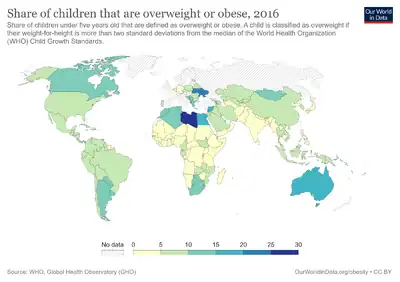
Diet plays an important role in the genesis of obesity. Personal choices, food advertising, social customs and cultural influences, as well as food availability and pricing all play a role in determining what and how much an individual eats.
Dietary energy supply
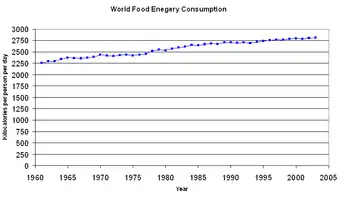
The dietary energy supply is the food available for human consumption, usually expressed in kilocalories per person per day. It gives an overestimate of the total amount of food consumed as it reflects both food consumed and food wasted. The per capita dietary energy supply varies markedly between different regions and countries. It has also changed significantly over time.[1] From the early 1970s to the late 1990s, the average calories available per person per day (the amount of food bought) has increased in all part of the world except Eastern Europe and parts of Africa. The United States had the highest availability with 3654 kilo calories per person in 1996.[2] This increased further in 2002 to 3770.[3] During the late 1990s, Europeans had 3394 kilo calories per person, in the developing areas of Asia there were 2648 kilo calories per person, and in sub-Sahara Africa people had 2176 kilo calories per person.[2][4]
Average calorie consumption
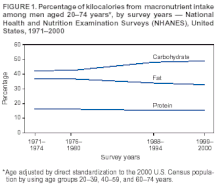
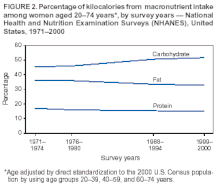

From 1971 to 2000, the average daily number of calories which women consumed in the United States increased by 335 calories per day (1542 calories in 1971 and 1877 calories in 2000). For men, the average increase was 168 calories per day (2450 calories in 1971 and 2618 calories in 2000). Most of these extra calories came from an increase in carbohydrate consumption, though there was also an increase in fat consumption over the same time period.[6] The increase in caloric consumption is attributed primarily to the "consumption of food away from home; increased energy consumption from salty snacks, soft drinks, and pizza; and increased portion sizes".[6] Other sources note that the consumption of soft drinks and other sweetened beverages now accounts for almost 25 percent of daily calories in young adults in America.[7] As these estimates are based on a person's recall, they may underestimate the amount of calories actually consumed.[6]
Fast food
As societies become increasingly reliant on energy-dense fast-food meals, the association between fast food consumption and obesity becomes more concerning.[8] In the United States, consumption of fast food meals has tripled and calorie intake from fast food has quadrupled between 1977 and 1995.[9] Consumption of sweetened drinks is also believed to be a major contributor to the rising rates of obesity.[10]
Portion size
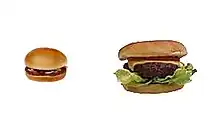
The portion size of many prepackage and restaurant foods has increased in both the United States and Denmark since the 1970s.[6] Fast food servings, for example, are 2 to 5 times larger than they were in the 1980s. Evidence has shown that larger portions of energy-dense foods lead to greater energy intake and thus to greater rates of obesity.[12][13]
Meat consumption
A 2010 study published in the American Journal of Clinical Nutrition closely tracked 373,803 people over a period of 8 years across 10 countries. At its conclusion, the study reported that meat consumption (processed meat, red meat, & poultry) is positively associated with weight gain and increased abdominal obesity in men and women.[14] In response, the National Cattlemen's Beef Association countered that increased meat consumption may not be associated with fat gain.[15] However, a subsequent response controlled for just abdominal fat across a sample of 91,214 people found that even when controlling for calories and subjects with cancer or smoking cessation, meat consumption is linked with obesity.[16] Further population studies, reviews, and meta-analysis studies have corroborated the claim that greater meat consumption is linked to greater rates of obesity,[17] especially in regards to red meat and processed meat.[18]
Sugar consumption
Drinking more sugary beverages (including fruit juices, soft drinks, fruit drinks, sports drinks, energy and enhanced water drinks, sweetened iced tea, and lemonade) increases overall energy intake, and thus increases the risk of metabolic syndrome, obesity, and type 2 diabetes (see Obesity#Pathophysiology).[19][20][21][22] Children who consume more added sugar in foods and beverages have a higher risk of becoming overweight.[21][22] By itself, sugar is not a factor causing obesity and metabolic syndrome, but rather – when over-consumed – is a component of unhealthy dietary behavior.[23] Adults who increase or decrease their free sugar intake increase or decrease their weight.[24]
Reviews indicate that governmental health policies should be implemented to discourage intake of sugar-sweetened beverages, and reduce the obesity in children and adults. Obesity has been rising in the 21st century.[19][20][21][22] Other than adding excessive calories, the mechanisms by which high sugar consumption causes obesity are unclear because of limitations in clinical research involving uncontrolled factors, such as overall diet, physical activity, and sedentary lifestyle.[19][20][25]
Ultraprocessed food consumption
Numerous large studies have demonstrated that eating ultraprocessed food has a positive dose-dependent relationship with both abdominal obesity and general obesity in both men and women.[26] Consuming a diet rich in unprocessed and minimally processed foods is linked with lower obesity risk and less chronic disease. These results are consistent among American,[27] Canadian,[28] Latin American,[29] British,[30] Australian,[31] French,[32] and Spaniard populations.[33]
Particular processing ingredients used in ultraprocessed foods have been linked with increasing the risk of obesity further. Intake of trans fat from industrial oils has been associated with increased abdominal obesity in men[34] and increased weight and waist circumference in women.[35] These associations were not attenuated when fat intake and calorie intake was accounted for.[36][37]
Similarly, heavy consumption of fried food is linked to greater obesity risk on a population level.[38] On a more individual level, the relative risk of fried food consumption and increased weight gain seems to depend on genetic predisposition.[39]
Social policy and change
New agricultural technologies have led to an overall reduction in the cost of food relative to household income, especially in high-income countries. In his popular book, "The Omnivore's Dilemma," the journalist Michael Pollan linked the subsidies offered to farmers of corn, soy, wheat, and rice through the U.S. farm bill to over-consumption of calories derived from these crops and to rising obesity rates.[40] While increased consumption of foods derived from these commodities is correlated with an increase in BMI (at the population level), no current research supports a causal relationship between farm subsidies and obesity.[41] From a policy perspective, the cost of sugar would actually decrease in the US if the commodity support programs in the farm bill were removed, largely due to the tariffs in the farm bill that restrict the importation of lower-cost sugar available on the global market.[42]
Participation by adults in the United States Department of Agriculture Supplemental Nutrition Assistance Program (i.e. Food Stamps) is positively associated with obesity, waist circumference, elevated fasting glucose, and metabolic syndrome.[43]
Metabolism
.svg.png.webp)
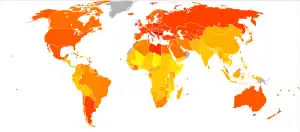
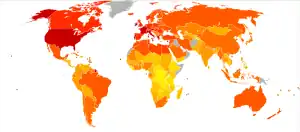
Evidence does not support the commonly expressed view that some obese people eat little yet gain weight due to a slow metabolism. On average obese people have a greater energy expenditure than normal weight or thin people and actually have higher basal metabolic rates.[45][46] This is because it takes more energy to maintain an increased body mass.[47] Obese people also underreport how much food they consume compared to those of normal weight.[48] Tests of human subjects carried out in a calorimeter support this conclusion.[49]
See also
- Abdominal obesity
- Criticism of fast food
- List of countries by dietary calorie intake
References
- ↑ "Compendium of food and agriculture indicators – 2006". UN Food and Agriculture Organization. Archived from the original on August 2, 2008. Retrieved January 10, 2009.
- 1 2 "Calories per capita per day" (gif). UN Food and Agriculture Organization. Archived from the original on September 1, 2017. Retrieved January 10, 2009.
- ↑ "www.fao.org" (PDF). UN Food and Agriculture Organization. Archived (PDF) from the original on January 14, 2009. Retrieved January 10, 2009.
- ↑ "USDA: frsept99b". USDA. Archived from the original on June 3, 2010. Retrieved January 10, 2009.
- ↑ "In the Long Run" (PDF). USDA. Archived from the original (PDF) on February 25, 2009. Retrieved February 17, 2009.
- 1 2 3 4 Centers for Disease Control Prevention (CDC) (February 2004). "Trends in intake of energy and macronutrients—United States, 1971–2000". MMWR. Morbidity and Mortality Weekly Report. 53 (4): 80–2. PMID 14762332. Archived from the original on 2019-06-20. Retrieved 2022-09-13.
- ↑ Caballero B (2007). "The global epidemic of obesity: an overview". Epidemiologic Reviews. 29: 1–5. doi:10.1093/epirev/mxm012. PMID 17569676.
- ↑ Rosenheck R (November 2008). "Fast food consumption and increased caloric intake: a systematic review of a trajectory towards weight gain and obesity risk". Obesity Reviews. 9 (6): 535–47. doi:10.1111/j.1467-789X.2008.00477.x. PMID 18346099.
- ↑ Lin BH, Guthrie J, Frazao E (1999). "Nutrient contribution of food away from home". In Frazão E (ed.). Agriculture Information Bulletin No. 750: America's Eating Habits: Changes and Consequences. Washington, DC: US Department of Agriculture, Economic Research Service. pp. 213–239. Archived from the original on 2002-06-11. Retrieved 2022-09-13.
- ↑ Olsen NJ, Heitmann BL (January 2009). "Intake of calorically sweetened beverages and obesity". Obesity Reviews. 10 (1): 68–75. doi:10.1111/j.1467-789X.2008.00523.x. PMID 18764885. S2CID 28672221.
- ↑ "Portion Distortion I". National Heart, Lung, and Blood Institute. 17 November 2004. p. 7 – via Wikimedia Commons.
- ↑ Ledikwe JH, Ello-Martin JA, Rolls BJ (April 2005). "Portion sizes and the obesity epidemic". The Journal of Nutrition. 135 (4): 905–9. doi:10.1093/jn/135.4.905. PMID 15795457.
- ↑ Steenhuis IH, Vermeer WM (August 2009). "Portion size: review and framework for interventions". The International Journal of Behavioral Nutrition and Physical Activity. 6: 58. doi:10.1186/1479-5868-6-58. PMC 2739837. PMID 19698102.
- ↑ Vergnaud AC, Norat T, Romaguera D, Mouw T, May AM, Travier N, et al. (August 2010). "Meat consumption and prospective weight change in participants of the EPIC-PANACEA study". The American Journal of Clinical Nutrition. 92 (2): 398–407. doi:10.3945/ajcn.2009.28713. PMID 20592131.
- ↑ Astrup A, Clifton P, Layman DK, Mattes RD, Westerterp-Plantenga MS (November 2010). "Meat intake's influence on body fatness cannot be assessed without measurement of body fat". The American Journal of Clinical Nutrition. 92 (5): 1274–5, author reply 1275–6. doi:10.3945/ajcn.110.000661. PMID 20844064.
- ↑ Vergnaud AC, Norat T, Romaguera D, Peeters PH (2010-11-01). "Reply to A Astrup et al". The American Journal of Clinical Nutrition. 92 (5): 1275–1276. doi:10.3945/ajcn.110.000786. ISSN 0002-9165.
- ↑ Lin Y, Bolca S, Vandevijvere S, De Vriese S, Mouratidou T, De Neve M, et al. (April 2011). "Plant and animal protein intake and its association with overweight and obesity among the Belgian population". The British Journal of Nutrition. 105 (7): 1106–16. doi:10.1017/S0007114510004642. PMID 21144092.
- ↑ Rouhani MH, Salehi-Abargouei A, Surkan PJ, Azadbakht L (September 2014). "Is there a relationship between red or processed meat intake and obesity? A systematic review and meta-analysis of observational studies". Obesity Reviews. 15 (9): 740–8. doi:10.1111/obr.12172. PMID 24815945. S2CID 43894954.
- 1 2 3 Luger M, Lafontan M, Bes-Rastrollo M, Winzer E, Yumuk V, Farpour-Lambert N (2017). "Sugar-Sweetened Beverages and Weight Gain in Children and Adults: A Systematic Review from 2013 to 2015 and a Comparison with Previous Studies". Obesity Facts. 10 (6): 674–693. doi:10.1159/000484566. PMC 5836186. PMID 29237159.
- 1 2 3 Hu FB (August 2013). "Resolved: there is sufficient scientific evidence that decreasing sugar-sweetened beverage consumption will reduce the prevalence of obesity and obesity-related diseases". Obesity Reviews. 14 (8): 606–19. doi:10.1111/obr.12040. PMC 5325726. PMID 23763695.
- 1 2 3 Malik VS, Pan A, Willett WC, Hu FB (October 2013). "Sugar-sweetened beverages and weight gain in children and adults: a systematic review and meta-analysis". The American Journal of Clinical Nutrition. 98 (4): 1084–102. doi:10.3945/ajcn.113.058362. PMC 3778861. PMID 23966427.
- 1 2 3 Guideline: Sugars intake for adults and children. WHO Guidelines Approved by the Guidelines Review Committee. World Health Organization. 2015. ISBN 978-92-4-154902-8. Archived from the original on 2022-06-20. Retrieved 2022-09-13.
- ↑ Joint WHO/FAO Expert Consultation (2003). "WHO Technical Report Series 916: Diet, Nutrition and the Prevention of Chronic Diseases" (PDF). Archived (PDF) from the original on 25 June 2016. Retrieved 25 December 2013.
- ↑ Sugars intake for adults and children Guideline (PDF). World Health Organization. 2015. ISBN 978-92-4-154902-8. Archived (PDF) from the original on 2018-08-19. Retrieved 2022-09-13.
Increasing or decreasing free sugars is associated with parallel changes in body weight, and the relationship is present regardless of the level of intake of free sugars.
- ↑ Stanhope KL (2016). "Sugar consumption, metabolic disease and obesity: The state of the controversy". Critical Reviews in Clinical Laboratory Sciences. 53 (1): 52–67. doi:10.3109/10408363.2015.1084990. PMC 4822166. PMID 26376619.
- ↑ Elizabeth L, Machado P, Zinöcker M, Baker P, Lawrence M (June 2020). "Ultra-Processed Foods and Health Outcomes: A Narrative Review". Nutrients. 12 (7): 1955. doi:10.3390/nu12071955. PMC 7399967. PMID 32630022.
- ↑ Monteiro CA, Cannon G, Moubarac JC, Levy RB, Louzada ML, Jaime PC (January 2018). "The UN Decade of Nutrition, the NOVA food classification and the trouble with ultra-processing". Public Health Nutrition. 21 (1): 5–17. doi:10.1017/S1368980017000234. PMID 28322183. S2CID 3876969.
- ↑ Nardocci M, Leclerc BS, Louzada ML, Monteiro CA, Batal M, Moubarac JC (February 2019). "Consumption of ultra-processed foods and obesity in Canada". Canadian Journal of Public Health. 110 (1): 4–14. doi:10.17269/s41997-018-0130-x. PMC 6964616. PMID 30238324.
- ↑ Pan American Health Organization (17 June 2019). Ultra-processed food and drink products in Latin America: Sales, sources, nutrient profiles, and policy implications. ISBN 978-92-75-12032-3. Archived from the original on 4 March 2021. Retrieved 15 March 2021.
- ↑ Rauber F, Steele EM, Louzada ML, Millett C, Monteiro CA, Levy RB (2020-05-01). "Ultra-processed food consumption and indicators of obesity in the United Kingdom population (2008-2016)". PLOS ONE. 15 (5): e0232676. Bibcode:2020PLoSO..1532676R. doi:10.1371/journal.pone.0232676. PMC 7194406. PMID 32357191.
- ↑ Machado PP, Steele EM, Levy RB, da Costa Louzada ML, Rangan A, Woods J, et al. (December 2020). "Ultra-processed food consumption and obesity in the Australian adult population". Nutrition & Diabetes. 10 (1): 39. doi:10.1038/s41387-020-00141-0. PMC 7719194. PMID 33279939.
- ↑ Beslay M, Srour B, Méjean C, Allès B, Fiolet T, Debras C, et al. (August 2020). "Ultra-processed food intake in association with BMI change and risk of overweight and obesity: A prospective analysis of the French NutriNet-Sant cohort". PLOS Medicine. 17 (8): e1003256. doi:10.1371/journal.pmed.1003256. PMC 7451582. PMID 32853224.
- ↑ Sandoval-Insausti H, Jiménez-Onsurbe M, Donat-Vargas C, Rey-García J, Banegas JR, Rodríguez-Artalejo F, Guallar-Castillón P (August 2020). "Ultra-Processed Food Consumption Is Associated with Abdominal Obesity: A Prospective Cohort Study in Older Adults". Nutrients. 12 (8): 2368. doi:10.3390/nu12082368. PMC 7468731. PMID 32784758.
- ↑ Koh-Banerjee P, Chu NF, Spiegelman D, Rosner B, Colditz G, Willett W, Rimm E (October 2003). "Prospective study of the association of changes in dietary intake, physical activity, alcohol consumption, and smoking with 9-y gain in waist circumference among 16 587 US men". The American Journal of Clinical Nutrition. 78 (4): 719–27. doi:10.1093/ajcn/78.4.719. PMID 14522729.
- ↑ Bendsen NT, Chabanova E, Thomsen HS, Larsen TM, Newman JW, Stender S, et al. (January 2011). "Effect of trans fatty acid intake on abdominal and liver fat deposition and blood lipids: a randomized trial in overweight postmenopausal women". Nutrition & Diabetes. 1 (1): e4. doi:10.1038/nutd.2010.4. PMC 3302130. PMID 23154296.
- ↑ Micha R, Mozaffarian D (1 September 2008). "Trans fatty acids: effects on cardiometabolic health and implications for policy". Prostaglandins, Leukotrienes, and Essential Fatty Acids. 79 (3–5): 147–52. doi:10.1016/j.plefa.2008.09.008. PMC 2639783. PMID 18996687.
- ↑ Kavanagh K, Jones KL, Sawyer J, Kelley K, Carr JJ, Wagner JD, Rudel LL (July 2007). "Trans fat diet induces abdominal obesity and changes in insulin sensitivity in monkeys". Obesity. 15 (7): 1675–84. doi:10.1038/oby.2007.200. PMID 17636085. S2CID 4835948.
- ↑ Guallar-Castillón P, Rodríguez-Artalejo F, Fornés NS, Banegas JR, Etxezarreta PA, Ardanaz E, et al. (July 2007). "Intake of fried foods is associated with obesity in the cohort of Spanish adults from the European Prospective Investigation into Cancer and Nutrition". The American Journal of Clinical Nutrition. 86 (1): 198–205. doi:10.1093/ajcn/86.1.198. PMID 17616781.
- ↑ Qi, Qibin; Chu, Audrey; Kang, Jae; Jensen, Majken; Curhan, Gary; Louis, Pasquale; De Vivo, Immaculata; Chan, Andrew; Choi, Hyon; Tamimi, Rulla; Ridker, Paul; Hunter, David; Willett, Walter; Rimm, Eric; Chasman, Daniel; Hu, Frank; Qi, Lu (25 March 2014). "Abstract 04: Fried Food Consumption and Genetic Predisposition to Obesity". Circulation. 129 (suppl_1): A04. doi:10.1161/circ.129.suppl_1.04. Archived from the original on 2 November 2022. Retrieved 15 March 2021.
- ↑ Pollan M (22 April 2007). "You Are What You Grow". New York Times. Archived from the original on 2019-07-17. Retrieved 2007-07-30.
- ↑ Siegel KR, McKeever Bullard K, Imperatore G, Kahn HS, Stein AD, Ali MK, Narayan KM (August 2016). "Association of Higher Consumption of Foods Derived From Subsidized Commodities With Adverse Cardiometabolic Risk Among US Adults". JAMA Internal Medicine. 176 (8): 1124–32. doi:10.1001/jamainternmed.2016.2410. PMC 6512298. PMID 27379488.
- ↑ Aubrey A (2016-07-18). "Does Subsidizing Crops We're Told To Eat Less Of Fatten Us Up?". NPR.org. Archived from the original on 2017-05-10. Retrieved 6 May 2017.
- ↑ Leung CW, Willett WC, Ding EL (January 2012). "Low-income Supplemental Nutrition Assistance Program participation is related to adiposity and metabolic risk factors". The American Journal of Clinical Nutrition. 95 (1): 17–24. doi:10.3945/ajcn.111.012294. PMC 3238460. PMID 22170370.
- 1 2 "Compendium of food and agriculture indicators – 2006". Food and Agriculture Organization of the United Nations. Archived from the original on August 2, 2008. Retrieved February 18, 2009.
- ↑ Kushner R (2007). Treatment of the Obese Patient (Contemporary Endocrinology). Totowa, NJ: Humana Press. p. 158. ISBN 978-1-59745-400-1. Archived from the original on November 2, 2022. Retrieved April 5, 2009.
- ↑ Crowe T. "Monday's medical myth: 'my slow metabolism makes me fat'". Archived from the original on 1 August 2017. Retrieved 15 November 2013.
- ↑ Adams JP, Murphy PG (July 2000). "Obesity in anaesthesia and intensive care". British Journal of Anaesthesia. 85 (1): 91–108. doi:10.1093/bja/85.1.91. PMID 10927998.
- ↑ Kopelman PG, Caterson ID, Stock MJ, Dietz WH (2005). Clinical obesity in adults and children: In Adults and Children. Blackwell Publishing. ISBN 978-1-4051-1672-5. Archived from the original on 2022-10-13. Retrieved 2022-09-13.
- ↑ "mdPassport". Archived from the original on January 11, 2009. Retrieved December 31, 2008.